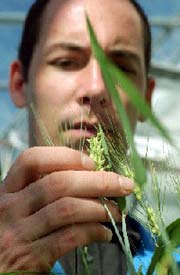Knowing when to flower

The secret of flowering in our major food crops like wheat has been revealed with the discovery by CSIRO Plant Industry of a gene that triggers flowering in cereals.
“Important cereal crops like wheat and barley rely on the gene we found, WAP1, to initiate flowering,” says Dr Ben Trevaskis, CSIRO Plant Industry.
“Flowering is important because it determines when the plant will produce grain or fruit – the parts we usually eat.”
WAP1 turns ’on’ to activate flowering when the cereal plant is at the right stage of development and when environmental conditions are suitable.
For example, in winter wheat, WAP1 and hence flowering is activated after a cold period, like winter. Spring wheat, however, flowers without exposure to cold because its version of WAP1 does not require a cold period to start it.
“Different flowering times in wheat are one of the key traits that wheat breeders have bred for since wheat breeding began,” says Dr Trevaskis.
“This breakthrough discovery of WAP1 means a piece of the flowering puzzle has been found. It helps us understand what breeders have been manipulating for thousands of years, but there is still a lot of work ahead of us to fully unravel the flowering process.”
In the future WAP1 could be used to help breed cereal plants that flower when needed.
“WAP1 could be used to modify flowering time in cereals. Experiments are now underway to see if spring wheats can be made to flower even earlier using more active versions of WAP1,” says Dr Trevaskis.
“WAP1 could potentially also be used to block flowering in grasses that cause allergies and prevent sugarcane flowering, allowing it to put more resources into cane production.”
The discovery of WAP1 has been simultaneously confirmed in the USA and Canada where scientists have independently identified the same gene for cereal flowering.
More information:
Dr Ben Trevaskis, CSIRO Plant Industry: 02 6246 5210, ben.trevaskis@csiro.au
Or visit www.csiro.au/flowering
Media assistance:
Sophie Clayton: 02 6246 5139, 0418 626 860, sophie.clayton@csiro.au
Media Contact
All latest news from the category: Life Sciences and Chemistry
Articles and reports from the Life Sciences and chemistry area deal with applied and basic research into modern biology, chemistry and human medicine.
Valuable information can be found on a range of life sciences fields including bacteriology, biochemistry, bionics, bioinformatics, biophysics, biotechnology, genetics, geobotany, human biology, marine biology, microbiology, molecular biology, cellular biology, zoology, bioinorganic chemistry, microchemistry and environmental chemistry.
Newest articles

Trotting robots reveal emergence of animal gait transitions
A four-legged robot trained with machine learning by EPFL researchers has learned to avoid falls by spontaneously switching between walking, trotting, and pronking – a milestone for roboticists as well…

Innovation promises to prevent power pole-top fires
Engineers in Australia have found a new way to make power-pole insulators resistant to fire and electrical sparking, promising to prevent dangerous pole-top fires and reduce blackouts. Pole-top fires pose…

Possible alternative to antibiotics produced by bacteria
Antibacterial substance from staphylococci discovered with new mechanism of action against natural competitors. Many bacteria produce substances to gain an advantage over competitors in their highly competitive natural environment. Researchers…





















